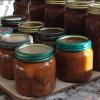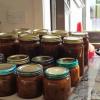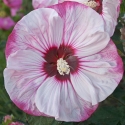Friday 3rd March, 2017
Hi
So it must be true LOL we are in Autumn..... officially
The first Autumn rains happened a couple weeks back, the days are shorter, the nights are cooler, the day time temps are hotter and those on the TV tell us that Autumn is officially here. To top all that off we are going to wind our clocks back an hour come the 2nd of April. What does this all mean for us keen gardeners.... well we are into what I would suggest is the best planting months of the year and the main season of harvest.
Why is this? It's because the ground temperatures are still warm and because we have started to get rain. Soils are moist which makes for really good root growth on new plants. Now these plants may not necessarily make much in the way of growth on the top, as in new leaves etc, but will certainly be putting out infrastructure as in roots underground for a massive leap forward next spring.
Even if we don't get too much more rain in the immediate future, because the days are shorter and nights are cooler it means that the ground will retain moisture for much longer. Especially if you water plants in well and mulch the soil surface, after all 4 more weeks we will be right into April. So if you have a planting project, a new garden to sort or a new hedge to get in, then now's the time to get onto it.
Planning and Planting a hedge that will be approx 1.2 m high
Preparation is the key to the success of most tasks and planting a hedge is no different. I would suggest creating an area as you would a garden so first measure out the length and create a space approx 70cm wide which will usually be the mature width of the grown hedge.
Prior to planting I would skim or spray the lawn or area so that its clear of all weeds and ready to be planted.
Plant all the plants at a measured 70 to 100 cm spacing depending on grade in the centre of the designated area. Plant slightly proud to the soil level so that when you back fill the area with mulch the plants end up with the back fill at the level they were in their container. I usually dig a hole larger that the container so that i can back fill the hole and sit the plant correctly and then complete the planting.
Tree bricks or
slow release fertiliser in the planting hole is also of benefit feeding the plant for a good start but ensure you put a good shovel full of dirt between the fert brick and the roots.
Back fill the entire area with shredded bark or similar which will suppress the weeds. I would then spot spray the weeds that grow with roundup or use one of the cut and paste brands as less soil movement will produce the least weeds. Don't allow weeds to grow around your hedge as these compete with the hedge plants for nutrients and water. Weeds also cause holes in the hedge as they grow in the place where the hedge should be growing. Don't ever use weedeaters around hedge plants as I know of many that have actually ring barked their plants which causes them to die.
If you are still making up your mind as to what plants to use for your hedging requirements you can check out our range by clicking this
link.
Tomato puree for the winter and beyond
Harry always used to tell me that the tomatoes from tins with the plastic coating inside affected his sleep at night... Sympathetic me used to think what a lot of rubbish until one day I read something to the effect that the plastic coating did in fact affect some people.. whether it does or doesn't, from that day onward we have preserved our own tomatoes and usually enough for the year ahead; beside there is nothing quite so good as the taste of
your own preserves.
Sometimes Harry gets carried away and a couple of years back he ordered 100 kg of tomatoes which we duly cooked and bottled...... so many agee jars were filled but now we are about to run out. So far this year we have a reasonably sedate 40 kg and I do say we rather loosely here as I think that H did most of the work.
These jars of tomato puree are just great for any cooking, stews, lasagnes, meat dishes, pastas.. we use it all the time. It is like having a cupboard full of sauces.
We grow a whole heap of Basil just for the project and its all rather simple to do and it's the usual story of just your time and effort needed to get it done.
Now you know that I'm not very good with measurements and so you'll have to guess and taste if you are going to follow what we do. You can add and subtract all sorts of flavours to the basics below like finely chopped bacon, perhaps diced onion and so on. Remember it is all about the flavour and what you enjoy.
Into large roasting pans
Tomatoes quartered or cut to a similar size depending on how big your tomatoes are
brown sugar to taste, say quarter to half a cup... too much is too sweet!
Balsamic vinegar quarter cup
Olive oil drizzled over the top, Harry used his Tarragon flavoured oil but normal will do
Salt and pepper to taste
Handfuls of basil loosely chopped or whatever herbs take your fancy! Thyme, rosemary oregano etc are all quite suitable
The trick is to add the chopped tomatoes over the herbs
Roast in the oven until the tomatoes are cooked juicy and oozing colour and fragrance. Roasting helps enhance the tomato flavours
Cool and then spoon into the kitchen whizz and blitz to a paste and pour into a large pot
Blitz all of the tomatoes and bring to a rapid boil in the pot ensuring that the tomatoes and herbs are well cooked and the mix is well heated and so will preserve properly.
Pour into cleaned sterilised and heated Agee jars, add seals and rings and wait for them to cool and lids go down. Too easy.
Wash and label jars and use over the next year or two.
Did you know? and new to us !! Perennial Hibiscus.
We all assume
Hibiscus are going be a large shrubs in the garden but there are a group of Hibiscus that are technically perennials. These have some of the largest blooms I ever did see and we have quite a smart selection of these in at the moment just coming up to flower with those super duper big flowers.
Hibiscus Berrylicious, Huge 20cm mauve lavender flowers with a deep strawberry red eye have attractively ruffled, overlapping petals. Produced on all sides of the dense, rounded clump of thick, bright green, maple-like leaves.
Hibiscus Cherry cheesecake...This long blooming hardy Hibiscus produces very large 20cm, white flowers with magenta tipped, ruffled petals and a magenta veining radiating out from the cherry red eye. It will be the star of your garden when in bloom! This plant forms a large, bushy, shrub-like clump of dark green foliage. Deciduous perennial.
Hibiscus Midnight Marvel, This breathtaking beauty will be the highlight of your garden with its dramatic wine-purple foliage and huge 20 cm round, deep scarlet red blossoms, which burst open from shiny, near-black buds. This hardy perennial will flower from summer through autumn. Keep this one moist to produce the most lush beautiful blooms. Deciduous perennial.
Hibiscus My Valentine, A stunning deciduous hibiscus that is fast growing from clumps with attractive foliage and large flowers - up to 20cm. A dramatic plant as the leaves develop and then the huge flowers begin to open. Clean up and cut back the plants at the end of winter. Apply generous amounts of balanced fertiliser. Mulch well. Likes consistant moisture. Deciduous perennial.
Hibiscus Tie Dye It's hard to beat the boldness of this gorgeous exotic hibiscus. Impressive 20cm blooms that are bright pink on the outer edges fading into a band of white surrounding a cherry red centre. These easy care plants like consistent moisture while flowering and will reward you with big gorgeous flowers throughout the season. Perennial deciduous.
Asclepias Fruiticosa is the proper and correct name for the plant that we all know as the Swan plant. Now the actual plant and flower is, well, quite an unassuming thing. However it does have quite the neatest seed capsules that have the rather interesting common name of Bishops Balls. I had remembered that it had an odd common name, so I googled it to refresh my memory, well there is somewhat of a resemblance to the male genitalia though not sure about its reference to Bishops.
On that note this unassuming plant does play host to the most gorgeous monarch butterfly and that is why we all love to grow it. Ang says to remember to keep the paperwasps and praying mantis's away as they love to eat the catapillers.
Great Plants just $12.99
Looks like a lovely fine weekend coming up so enjoy your gardens, friends and some good food and hopefully you will be harvesting your next harvest soon.
Lloyd, Harry and the Wairere Team
Make it a Wairere weekend where even GNOMES know that gardening's not a drag.














